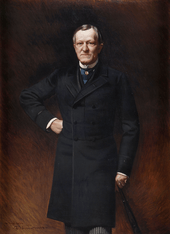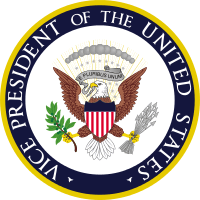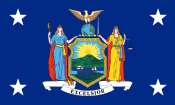Levi P. Morton
| Levi P. Morton | |
|---|---|
 | |
| 22nd Vice President of the United States | |
|
In office March 4, 1889 – March 4, 1893 | |
| President | Benjamin Harrison |
| Preceded by | Thomas A. Hendricks |
| Succeeded by | Adlai E. Stevenson |
| 31st Governor of New York | |
|
In office January 1, 1895 – December 31, 1896 | |
| Lieutenant | Charles T. Saxton |
| Preceded by | Roswell P. Flower |
| Succeeded by | Frank S. Black |
| United States Minister to France | |
|
In office March 21, 1881 – May 14, 1885 | |
| Appointed by | James A. Garfield |
| Preceded by | Edward Follansbee Noyes |
| Succeeded by | Robert Milligan McLane |
| Member of the U.S. House of Representatives from New York's 11th district | |
|
In office March 4, 1879 – March 21, 1881 | |
| Preceded by | Benjamin A. Willis |
| Succeeded by | Roswell P. Flower |
| Personal details | |
| Born |
Levi Parsons Morton May 16, 1824 Shoreham, Vermont, U.S. |
| Died |
May 16, 1920 (aged 96) Rhinebeck, New York, U.S. |
| Nationality | American |
| Political party | Republican |
| Spouse(s) |
|
| Children | 7 |
| Religion | Episcopalian |
| Signature |
 |
Levi Parsons Morton (May 16, 1824 – May 16, 1920) was a Representative from New York and the 22nd Vice President of the United States (1889–93). He later served as the 31st Governor of New York.
Early life
Morton was born in Shoreham, Vermont. His parents were the Reverend Daniel Oliver Morton (1788–1852), a Congregationalist minister of old New England stock, and Lucretia Parsons (1789–1862). His older brother, David Oliver Morton (1815–59), was Mayor of Toledo, Ohio, from 1849 to 1850.[1]
He left school early and worked as a clerk in a general store in Enfield, Massachusetts, taught school in Boscawen, New Hampshire, engaged in mercantile pursuits in Hanover, New Hampshire, moved to Boston, entered the dry-goods business in New York City, and engaged in banking there. He was an unsuccessful candidate for election in 1876 to the 45th Congress, but he was appointed by President Rutherford B. Hayes to be an honorary commissioner to the Paris Exhibition of 1878.
Political career
Member of Congress
Morton was elected, as a Republican, to the 46th and 47th Congresses representing Manhattan. He served from March 4, 1879, until his resignation, effective March 21, 1881. The 1880 Republican presidential nominee, James A. Garfield, asked Morton to be his vice presidential running mate, but Morton declined the offer.
Minister to France
After Garfield's election, Morton asked to be appointed United States ambassador to either the United Kingdom or France. He was U.S. Minister Plenipotentiary to France from 1881 to 1885. (A deluded Charles J. Guiteau, reportedly decided to murder Garfield after he was "passed over" as minister to France.)
Morton was very popular in France. He helped commercial relations between the two countries run smoothly during his term, and, in Paris on October 24, 1881, he placed the first rivet in the construction of the Statue of Liberty. (It was driven into the big toe of Lady Liberty's left foot.)
Vice President
Morton was elected Vice President of the United States, on the Republican ticket with President Benjamin Harrison, in which capacity he served from March 4, 1889, to March 4, 1893. During his term, Harrison tried to pass the Lodge Bill, an election law enforcing the voting rights of blacks in the South, but Morton did little to support the bill against a Democratic filibuster in the Senate. Harrison blamed Morton for the bill's eventual failure, and, at the Republican convention prior to the 1892 election, Morton decided not to run for a second term and was replaced by Whitelaw Reid as the vice-presidential candidate.[2] Harrison and Reid went on to lose the 1892 election, to Grover Cleveland and Adlai E. Stevenson, the Democratic candidates.
Governor of New York

Levi Morton was Governor of New York in 1895 and 1896. He was considered for the Republican presidential nomination in 1896, but the Republican Party chose William McKinley instead. After his public career was over, he became a real estate investor.
Marriages and personal life
Morton married his first wife, Lucy Young Kimball (July 22, 1836 – July 11, 1871) on October 15, 1856, in Flatlands, Brooklyn. They had one child, a daughter who died in infancy, in 1857.
After her death, Morton married Anna Livingston Reade Street in 1873. She was Second Lady of the United States during her husband's vice–presidency, and often handled entertaining duties for the administration due to First Lady Caroline Harrison's illness and ultimate death. They had five daughters, and a son who died in infancy.
In 1890 he became one of the first members of the District of Columbia Society of the Sons of the American Revolution. He was assigned national society membership number 1838 and district society number 38. [3]
In retirement, he served as President of the Metropolitan Club at One East Sixtieth Street, New York, between 1900 and 1911. He was preceded in that office by J. Pierpont Morgan; and succeeded by Frank Knight Sturgis. He was also a member of the Union League Club of New York, and served as President of the New York Zoological Society from 1897 to 1909.
Death
Morton died on May 16, 1920, at Rhinebeck, in Dutchess County, New York.[4] He died on his 96th birthday, the only Vice President to have died on his birthday. He is interred in the Rhinebeck Cemetery.
Legacy
The Village of Morton Grove, Illinois, is named after Morton. He provided the funding necessary to allow Miller's Mill (now Lincoln Avenue) to pass through the upstart neighborhood, and provide goods to trade and sell. Morton Grove was incorporated in December 1895.
Morton owned property in Newport, Rhode Island, and lived on fashionable Bellevue Avenue, in the mansion called "Fairlawn," a building currently owned by Salve Regina University, housing the Pell Center of International Relations and Public Policy. He left a nearby property to the city of Newport for use as a park. At the corner of Coggeshall and Morton avenues (the latter formerly Brenton Road), this land became Morton Park.
Morton sold or donated property he owned in Hanover, New Hampshire, to Dartmouth College, and the college built Webster Hall on the land. Morton was considered an honorary alumnus at alumni gatherings in New York. He also owned a summer retreat in the Adirondack Park, on Eagle Island.[5] The architecture is of the Great Camps style, designed by the notable architect William L. Coulter. Over the years, the island found its way into the ownership of the Girl Scouts of the USA, where it remains today as Camp Eagle Island. [6]
Morton was the second longest-lived Vice President of the United States, dying on his 96th birthday. Only Franklin D. Roosevelt's first Vice President, John Nance Garner (who died 15 days before his 99th birthday) lived longer. Morton survived five of his successors in the vice presidency: Adlai E. Stevenson, Garret Hobart, Theodore Roosevelt, Charles W. Fairbanks and James S. Sherman.
See also
- Place des États-Unis, Paris, France
References
- ↑ "Partial Genealogy of the Mortons of New York, Plymouth, and Ohio" (PDF).
- ↑ "Vice Presidents of the United States, 1789-1993" (PDF). United States Senate Historical Office. 1997. Retrieved 2008-10-25.
- ↑ http://interactive.ancestry.com/2204/32596_242034-00137?pid=17985&backurl=http%3a%2f%2fsearch.ancestry.com%2f%2fcgi-bin%2fsse.dll%3findiv%3d1%26db%3dSARMemberApps%26gss%3dangs-d%26new%3d1%26rank%3d1%26gsfn%3dlevi%26gsfn_x%3d1%26gsln%3dmorton%26gsln_x%3d1%26MSAV%3d1%26uidh%3dvt7%26pcat%3d39%26fh%3d0%26h%3d17985%26recoff%3d%26ml_rpos%3d1&treeid=&personid=&hintid=&usePUB=true#?imageId=32596_242034-00137
- ↑ "Morton A Resident Of Washington. Only Part of His Estate Will Be Taxable in This State. But Suit Will Be Brought. Test Was Attempted In the Case of Mrs. Morton, but Never Reached Conclusion". New York Times. May 18, 1920. Retrieved 2015-05-16.
The estate of ex-Governor Levi P. Morton will probably Day to the State of New York only the inheritance tax due from the estate of a non-resident, as Mr. Morton had made Washington, D.C., his residence for ten years.
- ↑ http://www.gscgehc.org/ca_eagle.html
- ↑ http://www.nps.gov/nhl/designations/samples/ny/Eagle%20Island%20Camp.pdf (PDF) (see page 4)
External links
| Wikimedia Commons has media related to Levi Morton. |
| Wikisource has the text of a 1911 Encyclopædia Britannica article about Levi P. Morton. |
- United States Congress. "Levi P. Morton (id: M001018)". Biographical Directory of the United States Congress.
- Levi P. Morton birthplace
- Levi P. Morton at Find A Grave
- Ancestors of Levi Parsons Morton
| Political offices | ||
|---|---|---|
| Preceded by Roswell P. Flower |
Governor of New York January 1, 1895 – December 31, 1896 |
Succeeded by Frank S. Black |
| Preceded by Thomas A. Hendricks |
Vice President of the United States March 4, 1889 – March 4, 1893 |
Succeeded by Adlai Stevenson |
| United States House of Representatives | ||
| Preceded by Benjamin A. Willis |
Member of the U.S. House of Representatives from New York's 11th congressional district March 4, 1879 – March 4, 1881 |
Succeeded by Roswell P. Flower |
| Party political offices | ||
| Preceded by John A. Logan |
Republican nominee for Vice President of the United States 1888 |
Succeeded by Whitelaw Reid |
| Diplomatic posts | ||
| Preceded by Edward F. Noyes |
United States Minister to France 1881–1885 |
Succeeded by Robert Milligan McLane |

